Ford Focus
2.0L Engine Spark Plugs Replacement Guide
How to check or change the spark plugs in
a 3rd generation MK3 2011-2014 Ford Focus with the Duratec 20 I4 engine.
By Paul B. Michaels Author & Photographer Auto Mechanic Since 1989 |
||
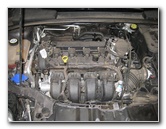 2012 Focus 2.0L I4 Engine |
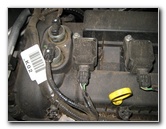 Spark Plug Ignition Coil |
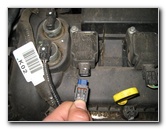 Press Tab - Remove Plug |
| This
automotive tutorial was specifically written to assist owners of the
third generation MK III (2011, 2012, 2013 & 2014) Ford Focus sedan
or hatchback equipped with the 2.0 liter Duratec 20 Ti-VCT GDI
inline four cylinder motor in checking or replacing the spark plugs. Owners of other Ford vehicles also equipped with the Duratec 20 engine such as the Fiesta, Transit Connect, C-Max, Mondeo, S-Max, EcoSport and Galaxy may also find these DIY instructions to be helpful. The items needed to complete this procedure include an 8mm socket, a 1/4" ratcheting wrench, a 5/8" spark plug socket, a 6" extension bar, a 3/8" drive ratcheting wrench, a spark plug gap gauge, dielectric grease & anti-seize lubricant (optional). The OEM iridium spark plugs in this 2012 Focus SEL are NGK part number SP-528 (CYFS-12-Y3 or CYFS12Y3). The correct replacement plugs for your car may be different depending on when it was built. According to the Ford Parts website, vehicles built before 5/31/2011 use the Motorcraft SP-522 plugs while Ford Focus models built after 6/1/11 use the Motorcraft SP-535 plugs. |
||
|
|
||
Please verify the correct replacement parts for your Focus by using the Amazon Part Finder website. The correct parts may vary depending on the model year, trim level and engine type (2.0L I4 Gasoline or 2.0L I4 Flex Fuel). A few aftermarket spark plugs that are compatible with the Duratec 2.0L I4 engine with their part numbers are as follows: NGK (6509) LTR6IX-11, ACDelco 17 RapidFire, Denso (5339) ITV20 and Autolite XP5363, |
||
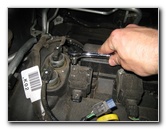 Remove 8mm Screw |
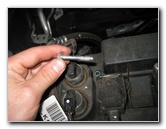 Ignition Coil Screw Removed |
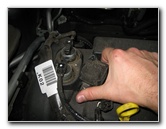 Rotate Ignition Coil |
| If you have access
to compressed air or a wet/dry shop vacuum, clean off the top of the engine
to help prevent debris from falling in to the spark plug wells. Press the release tab on the electrical connector for the first spark plug and slide it straight off the ignition coil. I'd recommend only checking or changing one spark plug at a time to further reduce the risk of dropping something down in to the cylinder head. Remove the one bolt holding the ignition coil in place by turning it counter clockwise with an 8mm socket and ratcheting wrench. Set the screw aside in a safe place. Rotate the ignition coil back and forth a few times to make sure that the rubber dust boot is not stuck to the tip of the old spark plug. |
||
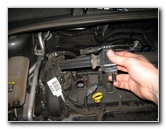 Pull Out Ignition Coil |
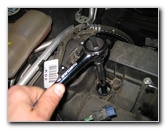 Attach 5/8" Spark Plug Socket |
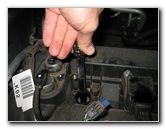 Spin Old Spark Plug |
| Lift the ignition
coil straight out of the spark plug well and set it aside in a safe place. Attach the 5/8" spark plug socket to the 6 inch extension bar and the 3/8" drive ratcheting wrench. Lower the socket down in to the well and attach it to the top of the old spark plug. Carefully loosen the old spark plug by turning the ratcheting wrench counter clockwise. If the old spark plug won't spin, do not use excessive force or you risk cracking the ceramic part of the plug. Spray a small amount of penetrating oil such as PB Blaster, Liquid Wrench or Kano Kroil and wait at least 15 minutes or more before attempting to loosen it again. If you don't have any penetrating oil, try spraying some WD-40 or warm up the engine for a few minutes to help expand the metal engine block. Once the spark plug is loose, detach the ratcheting wrench and spin it out by hand with your fingers at the end of the 6" extension bar. |
||
|
|
||
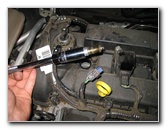 Lift Plug From Well |
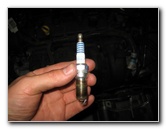 Old NGK CYFS12Y3 |
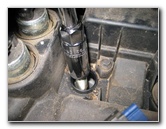 Lower In New Plug |
| Lift the spark plug
out of the well and detach it from the socket. If the end of the old spark plug looks ashy white, the plugs may have been exposed to high temperatures such as overheating or they are the incorrect heat range for your driving conditions or environment. On the other hand, if the old spark plugs are dark grey or covered in black soot, the engine may be burning oil and should be checked out by a professional mechanic. The OEM (original equipment manufacturer) spark plugs on this 2012 Ford Focus SEL are the "iridium" tipped Motorcraft part number SP-528 (also known as the NGK CYFS-12-Y3 or CYFS12Y3). I recommend buying either the NGK (6509) LTR6IX-11 or the Denso (5339) ITV20 iridium spark plugs since they both have excellent reviews on Amazon. The new iridium tipped spark plugs should be pre-gapped from the factory. It is still a good idea to check that the gap is correct using a spark plug gap gauge disc. If the gap is not very close to the number listed in the manufacturer's specifications, it may have been damaged in shipping or it is a defective part that should be exchanged for a new one. |
||
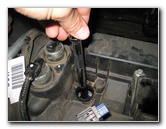 Spin In By Hand |
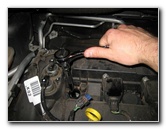 Attach Ratcheting Wrench |
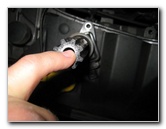 Apply Dielectric Grease |
| Push the new spark
plug in to the socket so that the rubber insert or magnet holds it securely
in place. Carefully lower the spark plug down in to the well and try to avoid hitting the electrode tip on the cylinder wall. Spin in the new spark plug by hand a few turns to prevent it from becoming cross threaded. Attach the 3/8" ratcheting wrench to the extension bar and tighten the new spark plug just barely past the point when you feel the crush washer collapse. They should be tightened to a small fraction of a turn just past finger tight. An optional step is to apply a tiny amount of anti-seize lubricant to the upper metal threads of the new spark plug. This will make the plugs easier to take out if they are not changed again for another 100k miles. Do not get any of the anti-seize on the electrode tip at the bottom of the new spark plug. Some spark plug manufacturers recommend against using anti-seize since it can lead to over tightening. If you do apply anti-seize to the threads of the new spark plug, less force will be necessary to tighten them. Do not over tighten the new plugs to avoid cracking the ceramic part of the plug or stripping the aluminum threads in the cylinder head. Double check that the new spark plugs are tight before continuing on to the following steps. Apply some dielectric grease to the opening of the rubber dust boots at the bottom of the ignition coils. This will help prevent them from becoming stuck to the tip of the new spark plugs and keep water or dust from interfering with the electrical connection. |
||
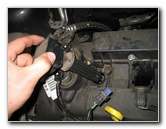 Re-Insert Ignition Coil |
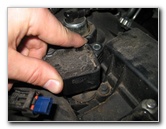 Rotate - Spread Grease |
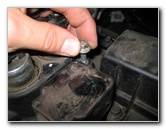 Insert 8mm Screw |
| Lower the ignition
coil down in to the spark plug well. Rotate the top of the coil a few times to help spread around the dielectric grease. Line up the bolt hole in the ignition hole with the corresponding hole in the top of the engine. |
||
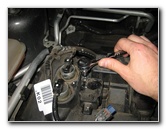 Tighten 8mm Screw |
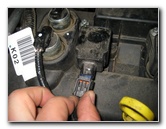 Push On Power Plug |
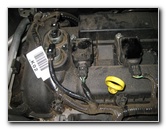 Spark Plug Replaced |
| Insert the screw in
to the ignition coil and tighten it to just past hand tight by turning it
clockwise with the 8mm socket and ratcheting. Push the power plug straight on to the ignition coil until it clicks securely in to place. Start up the engine and listen for any strange sounds that may indicate a problem. For more,
check out my other
Ford Focus Repair & Maintenance
Guides. |
||
| If you found this guide to be helpful,
please consider making a small donation by clicking on the PayPal.com
"Donate" button located to the right of this paragraph. Thank you!
(Note: I am not a registered charity. Donations are not tax deductible.) |

